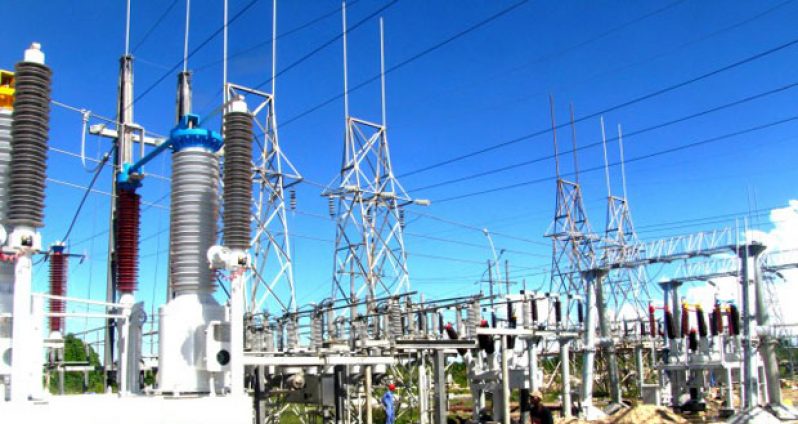Guyana’s energy policy seeks to provide an affordable degree of electrification to all persons in Guyana within an economically, environmentally and socially sustainable framework. The energy and electricity sector fall under the mandate of the Office of the Prime Minister, and in 2013, a significant amount of work was done in the realisation of this.
Energy Week 2013 – Abu Dhabi
In January, a delegation from Guyana including Prime Minister, Samuel Hinds and Dr. Mahender Sharma, Chief Executive Officer of the Guyana Energy Agency (GEA) attended the Abu Dhabi Sustainability Week of

events in Abu Dhabi, United Arab Emirates (UAE). The Guyana team attended several other activities including the General Assembly of the International Renewable Energy Agency (IRENA); the World Future Energy Summit; and the Meeting of Energy Ministers from South American and Arab countries. The latter explored the possibilities for growth and development in the energy sectors of the two regions, with a special focus on renewable energy.
Although the UAE and neighbouring countries have great resources of low cost oil reserves from which they earn tremendous revenue, they are preparing for a generation or two ahead, when their reserves may be exhausted and when the environmental charges on fossil fuels may put a brake on their consumption.
Energy efficiency
There have been programmes initiated to develop expertise and experience in measuring the use of electricity and total energy. The GEA commenced energy audits on over 30 government buildings to determine their levels of electricity consumption, and to discern opportunities for reducing energy consumption.
The Guyana Manufacturing and Services Association (GMSA), with support from the Inter-American Development Bank (IDB) has undertaken a similar programme, and at a review meeting towards the end of the year, Prime Minister Samuel Hinds encouraged private sector companies to participate and invest more in these programmes.

Renewable energy
There is continued focus on the potential to develop several renewable energy and energy from waste initiatives. Among them are PV solar and wind power, bio-ethanol production, bio diesel, bio gas and solar water heaters.
Following up on Guyana’s participation in a Sustainable Energy for All meeting in India in October 2012, two experts visited the GEA to pursue the use of bio-waste, rice husk and wood waste, for the generation of energy and electricity. They visited several rice mills and made a presentation on what they considered to be good possibilities for utilising rice husk and wood waste in Guyana. They proposed that for smaller units, the gasifier technology which had been demonstrated to the Guyana team in October 2012 was their preferred option, and for larger installations, above about 300 KVA, steam raising boilers and turbines were preferred.
The GEA has been collaborating with the Office of Climate Change in the Office of the President which has been pursuing similar studies with the Energy and Resources Institute (TERI) of India.
Electricity
Completion of Conversion
In keeping with a decision from the mid 1970s of having a single frequency of 60 HZ across Guyana, the Guyana Power and Light (GPL) continued the conversion of the remaining portion of its 50Hz network in Georgetown. This exercise included the frequency conversion of the generating units at the Wartsila Kingston 1, Plant from 50Hz to 60 Hz.
Transmission upgrade
GPL continued its upgrade of its transmission system which has seen the first construction of substations at points in its network. The programme costing over US $40M entails the construction of seven new 69/13.8 kV sub-stations, the expansion/upgrade of three existing 69/13.8 kV sub-stations, construction of approximately 96 km of 69 kV transmission lines, including a link between the Demerara and Berbice Interconnected Systems; 2.1 km of submarine cable; the construction of a new central control centre with SCADA capabilities, and installation of 251 km of fiber optic cable along the transmission line.
Already, two new substations at Edinburgh, W.C.D and Vreed-en-Hoop, and one expanded substation at Kingston, Georgetown and 14 km of interconnecting transmission lines with fiber optic cable were constructed and commissioned and are in service. Work continued on the construction of the remaining five new substations at New Sophia, Good Hope, New Georgetown, Columbia (Mahaicony) and Golden Grove, E.B.D, two expanded/upgraded stations at Sophia and Onverwagt W.C.B, the central control centre and 80 km of interconnecting transmission lines and fibre optic cable. The project is almost complete.
Additional Thermal Generation
Work began on a new 26 MW Heavy Fuel Oil (HFO) generating station at Vreed-en-Hoop, costing about US$32M. The old, much smaller station at Versailles will be retired.
Improved Metering and Loss Reduction
In its ongoing programme to reduce losses, GPL began a pilot project of installing 2,000 ‘smart meters’ in Central Georgetown. Though more costly, these could provide a platform to eliminate manual meter reading and the problems associated therewith, and provide a range of benefits to customers and to GPL.
Economic Services Committee scrutiny
The Prime Minister along with officials of the GPL, GEA and HEU (Hinterland Electrification Unit) appeared before the joint sittings of the Parliamentary Sectoral Committees on Economic Services and Natural Resources to answer questions about the functioning of their agencies.
Developing Hydro power
Despite the setback in Parliament for the Amaila Falls development, hydropower offers the only realistic potential for much lower cost electricity and increased security. Accordingly, Government is continuing to pursue ways to realise the development of the Amaila Falls site.
Under the Memorandum of Understanding entered into between the Governments of Guyana and Brazil for the development of certain infrastructure projects for mutual benefit, a very favourable preliminary study was submitted for harnessing sites on the Upper and Lower Mazaruni. There were similar studies in the 1970s – the problems highlighted then have been taken into account – the area that may be flooded has been reduced by 80%.
Government has been facilitating the two proposed gold mines at Aurora and Teparo to study potential nearby hydropower sites on the Cuyuni and Kurupung Rivers, respectively.
Hinterland electrification
The capability of mini grids is being gradually improved and several locations have been identified for the strengthening and extension of existing rudimentary grids. Residents of Lethem can look forward to improvement in their supply with the purchase of two new 750 KVA generating sets to be installed in a new power station on higher ground.
The programme funded entirely by Government which provided 11,000 65-watt PV-SHS to be installed in homes of 184 villages across the hinterland was successfully completed by the end of the first quarter.
These units provide an average about 10 kilowatt hours per month to each home. They added to the about 2,299 units installed in previous programmes. At the end of the year contracts were approved for a further 540 units for new homes in several villages, and 6,000 units for homes between the GPL network and the hinterland.
PetroCaribe
PetroCaribe was set up to provide a cushion to governments of participating countries, providing them time to adjust their use of fuels, make lifestyle changes, and convert to renewable energy sources. The intention was also to promote trade amongst member countries, as some of the fuel costs could be met by supplying goods and services. Thus, the Guyana Petro Caribe Agreement continued to facilitate the export sale of rice to Venezuela for mutual benefit.
The rice and paddy supplied to Venezuela is discounted against what Guyana owes on fuel. The money that accumulated in this account has been used to finance two power plants for the Guyana Power and Light (GPL) Incorporated; while some went towards the financing of the Hope Canal.
(GINA)












